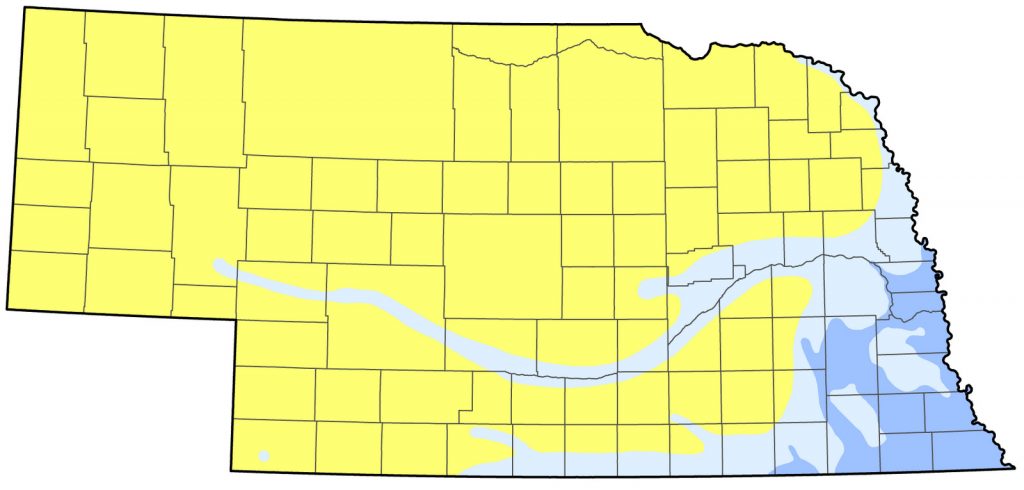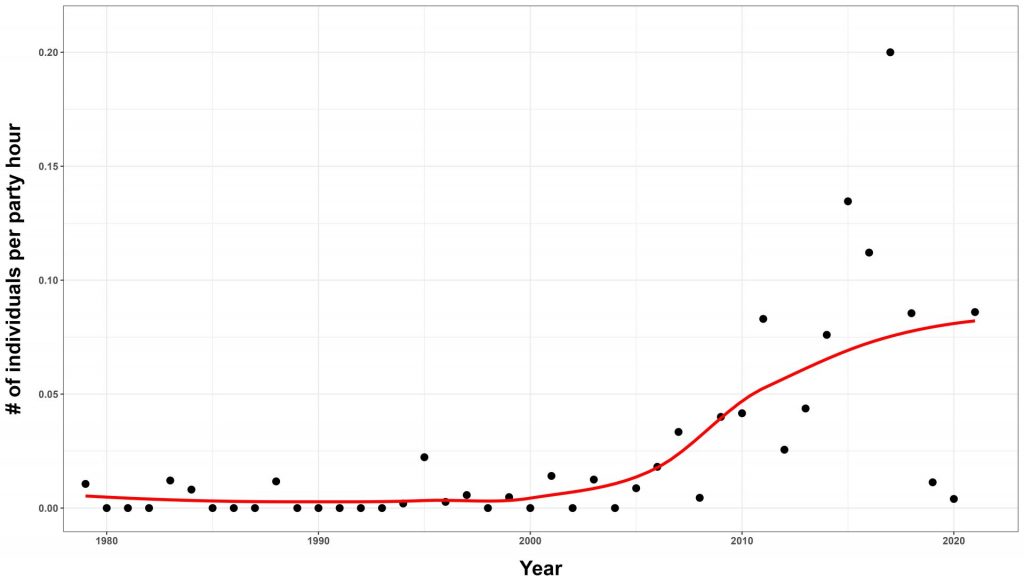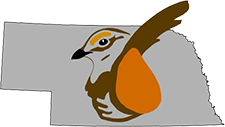Setophaga coronata coronata
Status: Common regular spring and fall migrant statewide. Rare regular winter visitor from North Platte and Platte River Valley counties south and Missouri River Valley in northeast, rare casual elsewhere.

Documentation: Specimen: UNSM ZM6857, 20 Apr 1901 Havelock, Lancaster Co.
Taxonomy: The subspecies coronata and auduboni were at one time considered separate species, Myrtle and Audubon’s Warblers respectively, but since 1983 have been treated as conspecifics due to the presence of hybrid zones from northwest British Columbia to southwest Alberta (Barrowclough 1980, AOU 1983). Curson et al (1994) suggested, however, that a more appropriate treatment is to consider the two taxa as two of four allospecies within the superspecies [S.] coronata, the others nigrifrons (Black-fronted Warbler) of the southwest United States and goldmani (Goldman’s Warbler) of southern Mexico. Analysis of a narrow hybrid zone in Alberta supports this treatment (Brelsford and Irwin 2009); although genetic distance between coronata and auduboni is slight, the hybrid zone has remained narrow and stable, suggesting assortative mating (Hunt and Flaspohler 2020). Indeed, Gill et al (2022) treat coronata, auduboni, and goldmani as full species, with nigrifrons a subspecies of Audubon’s Warbler.
Genetic evidence suggests that, rather than Myrtle and Audubon’s arising as a result of allopatric isolation, Audubon’s is a rare avian example of a taxon of hybrid origin. Its genome contains alleles derived from both presumed parental taxa, migratory Myrtle and non-migratory Black-fronted (Brelsford et al 2011); isotope studies show that Audubon’s possesses Myrtle rather than Black-fronted genes at an allele associated with migration (Toews et al 2014), resulting in the migratory capability of Audubon’s Warbler.
The westernmost populations of Myrtle Warbler have been considered separable as hooveri (Curson et al 1994; Dunn and Garrett 1997); this taxon has been described as breeding from Alaska south to British Columbia and wintering from Colorado, Kansas, and Missouri southward (AOU 1957). However, although Pyle (1997) considered differences between coronata and hooveri only clinal and insufficient to warrant subspecific status, Gill et al (2022) retained hooveri along with coronata as subspecies of coronata.
Rapp et al (1958) stated that hooveri (=coronata) occurred in Nebraska.
Intergrades (hybrids if coronata and auduboni are treated as separate species) are discussed in the “Hybrids” section under “Myrtle Warbler x Audubon’s Warbler (hybrid)“.
Changes since 2000: Numbers occurring during winter increased sharply 2005-2016 based on CBC data per party hour (Figure 1). That trend has ceased and appears to have reversed course as relatively low numbers were recorded on CBCs in 2019-2020 and 2020-2021. Prior to winter 2007-2008 there had been only 11 records in all for Feb, but numbers began to increase subsequently until the unprecedented count of 16 in Feb 2014-2015. See Winter below. Figure 1. Number of Yellow-rumped Warblers recorded per party hour during Christmas Bird Counts in Nebraska during the period 1980 to 2021. Points represent reported values and trend line created using locally weighted scatterplot (LOESS) smoothing. Data collected by volunteers and provided by National Audubon Society and the Nebraska Ornithologists Union.
Figure 1. Number of Yellow-rumped Warblers recorded per party hour during Christmas Bird Counts in Nebraska during the period 1980 to 2021. Points represent reported values and trend line created using locally weighted scatterplot (LOESS) smoothing. Data collected by volunteers and provided by National Audubon Society and the Nebraska Ornithologists Union.
Spring: winter <<<>>> May 30, 31, 31 (south, east); Apr 8, 9, 10 <<<>>> May 20, 21, 21 (north, west)
Earlier dates north and west (Myrtle) are 13 Mar 2011 Custer Co, 30 Mar 2018 Knox Co, 2 Apr 2012 Custer Co, 4 Apr 2010 Custer Co, and 6 Apr 2019 Brown Co.
Later dates north and west are 31 May 2025 Scotts Bluff Co, 31 May 2025 (2) Kimball Co, 31 May 2025 Wildcat Hills SRA, Scotts Bluff Co, 3 Jun 2018 Brown Co, and 12 Jun 2010 Garden Co. Jun dates were reported as “Myrtle” warblers.
Migrants are discernible in the north and west by mid-Apr; peak counts occur in early to mid-May.
There are a few reports Jun-Aug without information on subspecies of these sightings; these are included in Audubon’s Warbler.
- High counts: 755 in Sarpy Co 11 May 1996, 340 at Marsh Wren Community Wetlands, Lancaster Co 3 May 2019, 260 at North Platte NWR, Scotts Bluff Co 3 May 1995, and 255 in Lancaster Co 10 May 1996.
Fall: Aug 30, 30, 31 <<<>>> Nov 6, 6, 8 (north, west); Sep 11, 11, 12 <<<>>> winter (south, east),
An extraordinary record was of an apparent adult male in Sarpy Co 29 Jul 2021 (Mary Clausen, photo).
Later dates in the north and west are 10 Nov 2022 Holt Co, 10 Nov 2023 Kimball Co, and 13 Nov 2015 Brown Co.
Migrants become noticeable in mid-Sep and peak migration is in early Oct. Numbers and distribution thereafter begin to decline, with the Sandhills and northern Panhandle vacated in Nov and by Dec most reports are from the south and east.
Later reports (Dec-Feb) away from the south and east are discussed under Winter.
- High counts: 133 at Cunningham Lake, Douglas Co 8 Oct 2022, 129 in Washington-Douglas Cos 13 Oct 1996, 120 in Nance Co 8 Oct 2006, and 120 at Branched Oak Lake SRA, Lancaster Co 6 Oct 2018.
Winter: As noted under Fall (above), by Dec most birds are found in the south. This distribution persists through Feb, but with much reduced numbers that vary markedly from year to year. Prior to winter 2006-2007, there had been only 11 reports for the state in Feb, but beginning in 2007, Feb reports have increased markedly, with nine in the winters 2006-2007 through 2013-2014, followed by an unprecedented 16 reports 2014-2015. There was a similar influx in winter 2015-2016; reports that winter brought the all-time total number of Feb reports to 41, 21 of these in the 2014-2015 and 2015-2016 winters. Reported numbers in recent Februarys have been variable, with best counts five in 2021-2022 and six in 2024-2025.
Reports in Dec in the north and west are 4 Dec 2016 Knox Co, 6 Dec 1988 Boone Co (Cortelyou 1989), 8 Dec 2020 (2) Knox Co, 19 Dec 2018 Wheeler Co, 20 Dec 2018 Garfield Co, 22 Dec 2020 Garfield Co, 28 Dec 2001 Keya Paha Co, 28 Dec 2010 Loup Co, two on 29 Dec 2001 Calamus-Loup CBC, and eight on 30 Dec 1995 Calamus-Loup CBC.
Statewide, numbers are lowest in Jan-Feb, when there are few reports in the north and west: 1 Jan 2015 Knox Co, 27 Jan 2019 Brown Co, 30 Jan 2010 Custer Co, 14 Feb 2015 Custer Co, and 16 Feb 2011 Wheeler Co.
Images
Abbreviations
CBC: Christmas Bird Count
SRA: State Recreation Area
UNSM: University of Nebraska State Museum
Literature Cited
American Ornithologists’ Union [AOU]. 1957. The AOU Check-list of North American birds, 5th ed. Port City Press, Baltimore, Maryland, USA.
American Ornithologists’ Union [AOU]. 1983. The AOU Check-list of North American birds, 6th ed. Allen Press, Lawrence, Kansas, USA.
Barrowclough, G.F. 1980. Genetic and phenotypic differentiation in a Wood Warbler (Genus Dendroica) hybrid zone. Auk 97 :655-668.
Brelsford, A., and D.E. Irwin. 2009. Incipient speciation despite little assortative mating: the Yellow-rumped Warbler hybrid zone. Evolution 63: 3050-3060 https://doi.org/10.1111/j.1558-5646.2009.00777.x.
Brelsford, A., B. Mila, and D.E. Irwin. 2011. Hybrid origin of Audubon’s Warbler. Molecular Ecology 20: 2380–2389.
Cortelyou, R.G. 1989. 1988 Christmas Count. NBR 57: 3-9.
Curson, J., D. Quinn, and D. Beadle. 1994. Warblers of the Americas. Houghton Mifflin Company, Boston, Massachusetts, USA.
Dunn, J.L., and K.L. Garrett. 1997. A field guide to warblers of North America. Houghton Mifflin Company, Boston, Massachusetts, USA.
Gill, F., D. Donsker, and P. Rasmussen (Eds). 2022. IOC World Bird List (v 12.2). Doi 10.14344/IOC.ML.12.2. http://www.worldbirdnames.org/.
Hunt, P.D. and D.J. Flaspohler. 2020. Yellow-rumped Warbler (Setophaga coronata), version 1.0. In Birds of the World (P. G. Rodewald, Editor). Cornell Lab of Ornithology, Ithaca, NY, USA. https://doi.org/10.2173/bow.yerwar.01.
Pyle, P. 1997. Identification Guide to North American Birds. Part I, Columbidae to Ploceidae. Slate Creek Press, Bolinas, California, USA.
Rapp, W.F. Jr., J.L.C. Rapp, H.E. Baumgarten, and R.A. Moser. 1958. Revised checklist of Nebraska birds. Occasional Papers 5, Nebraska Ornithologists’ Union, Crete, Nebraska, USA.
Toews, D.P.L., A. Brelsford, and D.E. Irwin. 2014. Isotopic variation across the Audubon’s–myrtle warbler hybrid zone. Journal of Evolutionary Biology 27: 1179–1191.
Recommended Citation
Silcock, W.R., and J.G. Jorgensen. 2025. Yellow-rumped Warbler (Setophaga coronata). In Birds of Nebraska — Online. www.BirdsofNebraska.org

Birds of Nebraska – Online
Updated 23 Jun 2025